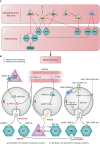Neuronal basis and diverse mechanisms of pathogen avoidance in Caenorhabditis elegans
- PMID: 38751431
- PMCID: PMC11094273
- DOI: 10.3389/fimmu.2024.1353747
Neuronal basis and diverse mechanisms of pathogen avoidance in Caenorhabditis elegans
Abstract
Pathogen avoidance behaviour has been observed across animal taxa as a vital host-microbe interaction mechanism. The nematode Caenorhabditis elegans has evolved multiple diverse mechanisms for pathogen avoidance under natural selection pressure. We summarise the current knowledge of the stimuli that trigger pathogen avoidance, including alterations in aerotaxis, intestinal bloating, and metabolites. We then survey the neural circuits involved in pathogen avoidance, transgenerational epigenetic inheritance of pathogen avoidance, signalling crosstalk between pathogen avoidance and innate immunity, and C. elegans avoidance of non-Pseudomonas bacteria. In this review, we highlight the latest advances in understanding host-microbe interactions and the gut-brain axis.
Keywords: aerotaxis; innate immunity; metabolites; neural circuit; pathogen avoidance; reactive oxygen species.
Copyright © 2024 Lei, Tan, Tu and Tan.
Conflict of interest statement
The authors declare that the research was conducted in the absence of any commercial or financial relationships that could be construed as a potential conflict of interest.
Figures


Similar articles
-
Behavioral avoidance of pathogenic bacteria by Caenorhabditis elegans.Trends Immunol. 2014 Oct;35(10):465-70. doi: 10.1016/j.it.2014.08.008. Epub 2014 Sep 15. Trends Immunol. 2014. PMID: 25240986 Review.
-
The genetics of pathogen avoidance in Caenorhabditis elegans.Mol Microbiol. 2007 Nov;66(3):563-70. doi: 10.1111/j.1365-2958.2007.05946.x. Epub 2007 Sep 17. Mol Microbiol. 2007. PMID: 17877707 Review.
-
Innate immunity in C. elegans.Adv Exp Med Biol. 2010;708:105-21. doi: 10.1007/978-1-4419-8059-5_6. Adv Exp Med Biol. 2010. PMID: 21528695 Review.
-
Octopaminergic Signaling Mediates Neural Regulation of Innate Immunity in Caenorhabditis elegans.mBio. 2018 Oct 9;9(5):e01645-18. doi: 10.1128/mBio.01645-18. mBio. 2018. PMID: 30301853 Free PMC article.
-
[Progress in the mechanisms of neural modulation of innate immunity in Caenorhabditis elegans].Yi Chuan. 2018 Dec 20;40(12):1066-1074. doi: 10.16288/j.yczz.18-133. Yi Chuan. 2018. PMID: 30559096 Review. Chinese.
Cited by
-
Microbial genetic composition regulates host social behavior.Gut Microbes. 2025 Dec;17(1):2536091. doi: 10.1080/19490976.2025.2536091. Epub 2025 Jul 23. Gut Microbes. 2025. PMID: 40702822 Free PMC article.
-
Behavioral adaptations of Caenorhabditis elegans against pathogenic threats.PeerJ. 2025 Apr 14;13:e19294. doi: 10.7717/peerj.19294. eCollection 2025. PeerJ. 2025. PMID: 40247835 Free PMC article. Review.
-
Modeling Host-Pathogen Interactions in C. elegans: Lessons Learned from Pseudomonas aeruginosa Infection.Int J Mol Sci. 2024 Jun 27;25(13):7034. doi: 10.3390/ijms25137034. Int J Mol Sci. 2024. PMID: 39000143 Free PMC article. Review.
References
-
- Goodall J. Social rejection, exclusion, and shunning among the gombe chimpanzees. Ethology Sociobiology. (1986) 7:227–36. doi: 10.1016/0162-3095(86)90050-6 - DOI
Publication types
MeSH terms
LinkOut - more resources
Full Text Sources

